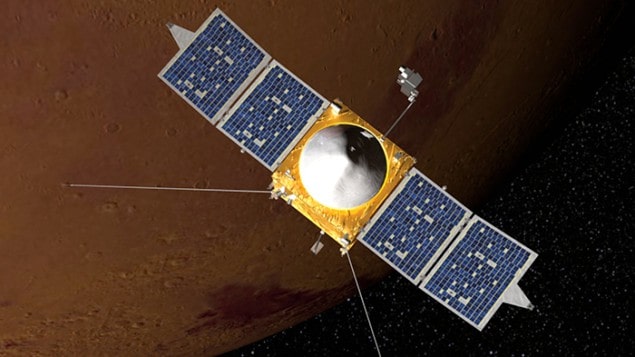
Tiny dust particles have been found floating more than 1000 km above the surface of Mars – about 10 times higher than planetary scientists had expected to find them. The particles were spotted by NASA’s MAVEN spacecraft, and their presence suggests that the red planet is accumulating dust from the solar system. The discovery could provide important clues about how dust moves around the solar system.
Scientists already knew that dust is lifted as much as 100 km from the surface of Mars by localized “dust devils” and global dust storms. Dust that is higher than about 150 km from the surface could come from the surface erosion of the Martian moons Phobos and Deimos. However, calculations suggest that this dust would enter the atmosphere via a doughnut-shaped ring around the planet – a ring that has not been detected by MAVEN.
Plasma clouds
The mysterious dust particles were seen by MAVEN as it follows a highly elliptical orbit of Mars, which varies in altitude from 150–6200 km. MAVEN began orbiting Mars in September 2014, and its Langmuir Probe and Waves (LPW) instrument detects dust by sensing the tiny plasma clouds that are created when dust particles strike the craft.
Because the entire surface of MAVEN acts as the detector, it can measure very low concentrations of dust. The size of each particle detected is estimated from the amplitude of its LPW signal, and the data were collected over seven months, which corresponds to more than 1000 passes to within 150 km of the Martian surface.
The data reveal a relatively constant concentration of dust particles from an altitude of about 1500 km down to about 500 km. At the lower heights, the number of particles increases rapidly, and is a factor of five greater at 150 km – the lowest altitude probed. Lab-based experiments suggest that the particles are about 1–12 μm in size, but the researchers cannot think of any known mechanism that could propel the dust from the surface to beyond a height of about 150 km.
Missing process
“If the dust originates from the atmosphere, this suggests we are missing some fundamental process in the Martian atmosphere,” says Laila Andersson, who is lead author on a paper in Science that analyses data from the LPW. Writing in the latest issue of Science, Andersson and colleagues reckon that the dust is interplanetary in origin and could be particles driven by the solar wind or debris brought into the inner solar system by comets.
If so, Mars will not be alone as a collector of interplanetary dust. The Earth’s atmosphere contains it too, and the team used previous measurements done on Earth to estimate how much interplanetary dust should be found on Mars. This calculation suggests that the LPW has only seen a small fraction of the interplanetary dust that could surround Mars.
Raving over MAVEN
Also in Science are three other papers reporting MAVEN results. The orbit of MAVEN was adjusted occasionally so that it dipped to within 120 km from the surface of Mars. These “deep-dip” campaigns took MAVEN to within the planet’s upper atmosphere, where Stephen Bougher of the University of Michigan and an international team measured the concentrations of gases including carbon dioxide, argon, nitrogen oxide and oxygen.
They found that the concentrations varied substantially from dip to dip, suggesting that the upper atmosphere is a dynamic place. The team also measured variations in the magnetic field of Mars from dip to dip. Its results suggest that both the crust of the planet and the solar wind contribute to the magnetic properties of Mars.
In another paper, Bruce Jakosky of the University of Colorado Boulder and colleagues describe how they used instruments on board MAVEN to work out how many ions escape from the Martian atmosphere during solar bursts. This information could help scientists to understand how a sizeable chunk of atmosphere could have been lost by Mars early in its history.
The final paper focuses on an aurora event that occurred in the planet’s northern hemisphere. Nick Schneider of the University of Colorado and colleagues used MAVEN’s Imaging Ultraviolet Spectrograph to study this Martian version of the northern lights, which they found to be more evenly distributed and diffuse than its terrestrial counterpart.
The four papers are published in a special issue of Science.



